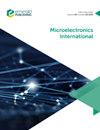Improving displacement of silicon V-shaped electrothermal microactuator using platinum sputter deposition process
IF 0.8
4区 工程技术
Q4 ENGINEERING, ELECTRICAL & ELECTRONIC
引用次数: 0
Abstract
Purpose This paper aims to propose a method to reduce the resistance of silicon-based V-shaped electrothermal microactuator (VEM) by applying a surface sputtering process. Design/methodology/approach Four VEM’s samples have been fabricated using traditional silicon on insulator (SOI)-Micro-electro-mechanical System (MEMS) technology, three of them are coated with a thin layer of platinum on the top surface by sputtering technique with different sputtered times and the other is original. The displacements of the VEM are calculated and simulated to evaluate the advantages of sputtering method. Findings The measured results show that the average resistance of the sputtered structures is approximately 1.16, 1.55 and 2.4 times lower than the non-sputtering sample corresponding to the sputtering time of 1.5, 3 and 6 min. Simulation results confirmed that the maximum displacement of the sputtered VEM is almost 1.45 times larger than non-sputtering one in the range of voltage from 8 to 20 V. The experimental displacements are also measured to validate the better performance of the sputtered samples. Originality/value The experimental results demonstrated the better displacement of the VEM structure after using the platinum sputtering process. The improvement can be considered and applied for enhancing displacement as well as decreasing the driving voltage of the other electrothermal microactuators like U- or Z-shaped structures while combining with the low-cost SOI-MEMS micromachining technology.利用铂溅射沉积工艺提高硅v型电热微执行器的位移
目的提出一种采用表面溅射工艺降低硅基V型电热微激励器(VEM)电阻的方法。设计/方法/方法使用传统的绝缘体上硅(SOI)-微机电系统(MEMS)技术制作了四个VEM样品,其中三个样品通过不同溅射时间的溅射技术在顶部表面涂覆了一层薄铂,另一个样品是原始的。对VEM的位移进行了计算和模拟,以评价溅射法的优点。测量结果表明,在1.5、3和6的溅射时间下,溅射结构的平均电阻分别比非溅射样品低约1.16、1.55和2.4倍 仿真结果表明,在8~20的电压范围内,溅射VEM的最大位移几乎是非溅射VEM最大位移的1.45倍 V.还测量了实验位移,以验证溅射样品的更好性能。独创性/价值实验结果表明,使用铂溅射工艺后,VEM结构的位移更好。这种改进可以考虑并应用于增强位移以及降低U形或Z形结构等其他电热微致动器的驱动电压,同时结合低成本的SOI-MEMS微加工技术。
本文章由计算机程序翻译,如有差异,请以英文原文为准。
求助全文
约1分钟内获得全文
求助全文
来源期刊

Microelectronics International
工程技术-材料科学:综合
CiteScore
1.90
自引率
9.10%
发文量
28
审稿时长
>12 weeks
期刊介绍:
Microelectronics International provides an authoritative, international and independent forum for the critical evaluation and dissemination of research and development, applications, processes and current practices relating to advanced packaging, micro-circuit engineering, interconnection, semiconductor technology and systems engineering. It represents a current, comprehensive and practical information tool. The Editor, Dr John Atkinson, welcomes contributions to the journal including technical papers, research papers, case studies and review papers for publication. Please view the Author Guidelines for further details.
Microelectronics International comprises a multi-disciplinary study of the key technologies and related issues associated with the design, manufacture, assembly and various applications of miniaturized electronic devices and advanced packages. Among the broad range of topics covered are:
• Advanced packaging
• Ceramics
• Chip attachment
• Chip on board (COB)
• Chip scale packaging
• Flexible substrates
• MEMS
• Micro-circuit technology
• Microelectronic materials
• Multichip modules (MCMs)
• Organic/polymer electronics
• Printed electronics
• Semiconductor technology
• Solid state sensors
• Thermal management
• Thick/thin film technology
• Wafer scale processing.
 求助内容:
求助内容: 应助结果提醒方式:
应助结果提醒方式:


